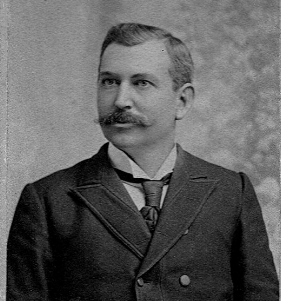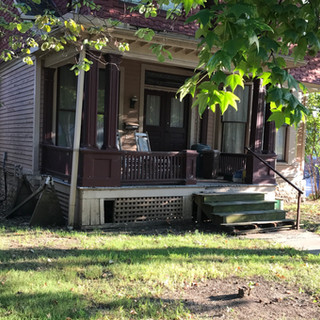Chowning name respected in both Twain circles and for health care expertise
- Mary Lou Montgomery

- Sep 22, 2017
- 5 min read

The late Dr. Thomas Chowning Jr., a native of Florida, Mo. His father was the attending physician for Sam Clemens’ birth, and Dr. Chowning Jr., was a physician and surgeon in Hannibal for 33 years until his death in 1925. Photo published May 15, 1966, in the Colorado Springs Gazette Telegraph. The photo belonged to William Vandel and his wife.
MARY LOU MONTGOMERY
During his day, Thomas Jefferson Chowning, M.D., was a prominent figure in Monroe County, Mo. In the spring of 1850, his name was entered into consideration as a candidate for the Senate. During the year following he was called upon by his contemporaries to establish a committee to plan improvements to the flow of Salt River. Serving on the committee as a director was John Quarles, brother-in-law to Jane Lampton Clemens.
Dr. Chowning didn’t realize it during his lifetime, but he would ultimately be best remembered for a routine medical procedure he performed on Nov. 30, 1835, when he assisted Jane Clemens in the delivery of her son, whom she named Sam (aka Mark Twain).
A native of Tennessee, in 1843 Dr. Chowning married Eliza Jane Sumner - a Missouri native - in Monroe County. There they lived on the family homestead at the west edge of Florida, Mo., with their two daughters, Sarah J. and Elizabeth Chowning, and the youngest of their children, a son, Thomas Chowning. Dr. Chowning was a slave owner, as was his neighbor, John Quarles.
Young Thomas Chowning was but two years old when his father passed, and his mother took on the responsibilities of raising her children and managing their farm.
Regardless of the lack of paternal influence in his life, young Thomas Chowning would follow in his father’s footsteps, by pursuing both a medical career, and a leadership role in his community.
Young Thomas
By 1880, Thomas Chowning had achieved his goal of becoming a physician. An 1875 graduate of the Medical School at Washington University in St. Louis, Mo, in 1880 he was living at Jefferson, Monroe County, Mo., with his mother, who would die the following year.
Seeing a need for a banking facility at Florida, Dr. Thomas and W.R. Wilkerson organized and established the Florida Savings Bank in 1890. Two years later, he opened a medical practice at Hannibal, Mo., where he would care for patients for the next 33 years.
919 Center St.
While still a bachelor, in 1895 Dr. Chowning boarded at a house located at 919 Center St., on the southeast corner of Center and Tenth streets in Hannibal. His landlady was Mrs. Johnson, and she provided a fine noon meal for her tenants.
The Quincy Daily Herald published a story about Dr. Chowning’s encounter with a “tramp” in its Sept. 9, 1895 edition.
“Ragged, dirty and hungry, he called at the doctor’s office and asked for a contribution to secure a meal, The doctor, instead of handing out a quarter for him to invest in ‘tanglefoot’ (cheap whiskey), penned an order on his landlady, Mrs. Johnson, for a meal, and directed the hungry wayfarer where to go.”
Mrs. Johnson, upon receipt of the unreadable note from the doctor, made an assumption that the man was an old friend of Dr. Chowning – who was down on his luck. She led the man up the stairs to an “elegant upper chamber, where she prepared a bowl and supplied it with water, and taking from the linen closet a snow white towel for the ‘doctor’s friend’ to make his toilet.”
The man – almost unrecognizable after washing up – sat down to the table, which was “spread with immaculate linen and ornamented with fine china, exquisite cut glass and silver.”
He eagerly partook in the food placed before him, the newspaper explained: “The viands fit for a king, steaming hot.”
When the doctor arrived for lunch and sat down at his usual spot at the table, he didn’t appear to recognize the man. That astonished Mrs. Johnson, who expected him to welcome his guest.
The tramp left the table and was on his way before Dr. Chowning realized he had just supplied a grand feast for this transient stranger.
Noteworthy patients
Dr. Chowning, a surgeon, treated many patients throughout his career.
In 1895, the marshal of Stoutsville, a man named Matt Tully, was shot in the forehead when trying to apprehend two suspected burglars. After he was wounded, he opened fire on the men, hitting one man in the back, while the other escaped. Dr. Chowning of Hannibal was called to Stoutsville to perform an operation on the gunshot victims. The marshal received only a scalp wound.
In 1896, Dr. Chowning assisted Drs. Howell, Hornback, Baskett and Kabler in operating on the three-year-old daughter of Ed. J. Bross of rural Palmyra. “The operation was the removal of one of the little girl’s eyes and was quite successful. It was performed at the home of Deputy Marshall Schaub, who is a relative of Mr. Bross,” the Hannibal Journal reported, and the Marion County Herald republished on April 2, 1896.
In 1897, Rev. Gallaher, pastor of the Presbyterian Church at Big Creek, had an accident with a buzz saw and two of his fingers were cut off. Drs. Baskett and Chowning performed surgery on the minister’s hand at Dr. Baskett’s home.
In 1898, Drs. Ferguson, Kabler, Chowning, Baskett, Goodier and DeGroat operated upon William Grimmer, who was shot in the stomach while working at the Hannibal and St. Joseph round house at Hannibal. “After placing the injured man under the influence of chloroform, (they) removed his intestines and found that the cruel bullet had plowed through the delicate parts, necessitating the closing up of ten perforations. This neatly done, the parts were replaced, but the attending physicians are of the opinion that the chances are largely against he recovery of the young man,” the newspaper reported.
And in 1906, Dr. Chowning was called upon to care for Capt. Robert L. Bowles, who was severely injured when his buggy was overtaken by runaway horses in the bottom lands north of Hannibal. Capt. Bowles was among the best known and richest men in Marion County, owning 5,000 acres in the Marion City bottoms.
“It was found that the victim had sustained several broken bones, including ribs, collar bone, shoulder blade and severe injuries about the head. All possible was done, but the tender hands of friends and skill of physicians never even nursed him back to consciousness,” the Quincy Herald Whig reported in its Aug. 10, 1906 edition.
In 1921, Dr. Chowning himself was injured while treating a patient. The Columbia Evening Missourian reported in its April 16, 1921 edition: “Dr. Thomas Chowning of Hannibal met with a peculiar accident while setting a broken arm for a patient. While the man was under the influence of an anesthetic he struck Chowning in the face, injuring his eye and breaking his glasses.”
Death calls
Dr. Chowning died of pneumonia on Sept. 25, 1925 at the age of 72. The funeral was conducted at his long-time home, 1103 Center St., Hannibal, and burial followed at the family plot located at Paris, Mo.
His wife, Alice Rushbrook Chowning, died May 9, 1928 and was buried beside her husband.
The couple was childless.






























Comments